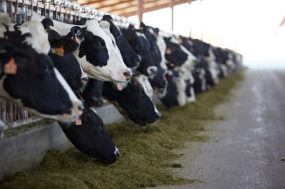Genetics and genomics
- Canadian dairy genetics are among the best in the world, and demand for Canadian dairy stock is on the rise. Since 1988, the total value of Canadian dairy genetic exports – including dairy cattle, embryos and semen – rose from almost $68 million to more than $158 million in 2014.
- Cows in official milk recording programs produced on average 10,102 kg of milk per lactation (305 days) with an average content of 3.87 percent fat and 3.19 percent protein.
- Breeding and genetic improvements resulted in a 194 percent increase in milk production per cow from 1970 to 2014.
Animal health and welfare
- National eradication programs for serious cattle diseases have been developed, several of which have been eradicated from the dairy herd (i.e., brucellosis).
- Mastitis research and discoveries are leading to a potential new strategy to control biofilm formation by pathogens; steps are ongoing for the development of a protective vaccine against Staphylococcus aureus – one of the main culprits for mastitis infections.
- The Animal Care Assessment program of proAction is based in sound science developed through the Code of Practice for the Care and Handling of Dairy Cattle requirements and research that produced Standard Operating Procedures for Animal Care financed through the Dairy Research Cluster.
Milk quality
- Canadian milk is among the highest-quality milk in the world. The Canadian Quality Milk program is a certification program established on the basis of food safety science and protocols that produce proven results.
- Canada has lowered the somatic cell count standard of 400,000 cells per millilitre since 2012.
Sustainable milk production
- Canadian milk’s carbon, land and water footprints are among the lowest globally.
o A carbon footprint of 1.01 kg of CO2e per kg of milk
o A water footprint of 20 litres of water per kg of milk
o A land footprint value of 1.7 square metres per kg of milk
- Continuous efficiency gains over time means fewer cows are needed to produce milk for the Canadian population. In 2014, there were 959,300 cows to produce 78.2 million hectolitres of milk compared to 2006, when 1.019 million cows produced 74.2 million hectolitres of milk.
Health and nutrition
- Milk products appear to be important for weight management. Evidence to date indicates that an adequate consumption of milk products may be a key factor in preventing overweight and obesity.
- Several studies, including meta-analyses, suggest that milk products are associated with a reduction in the risk of stroke and Type 2 diabetes, an important global health and economic burden.
- There is growing evidence of the potential of milk as an optimal exercise beverage, especially after resistance training and endurance sports. Loaded with nutrients, milk is readily available and a cost-effective alternative to traditional sports beverages (Prof. Roy, Brock University). PD
Dairy Farmers of Canada (DFC) is the national policy, lobbying and promotional organization representing Canada’s farmers. DFC works to support sustainable dairy production; facilitate solutions to provincial/national challenges; provide credible research of dairy products on a national basis; and create innovative ways to grow the market.








